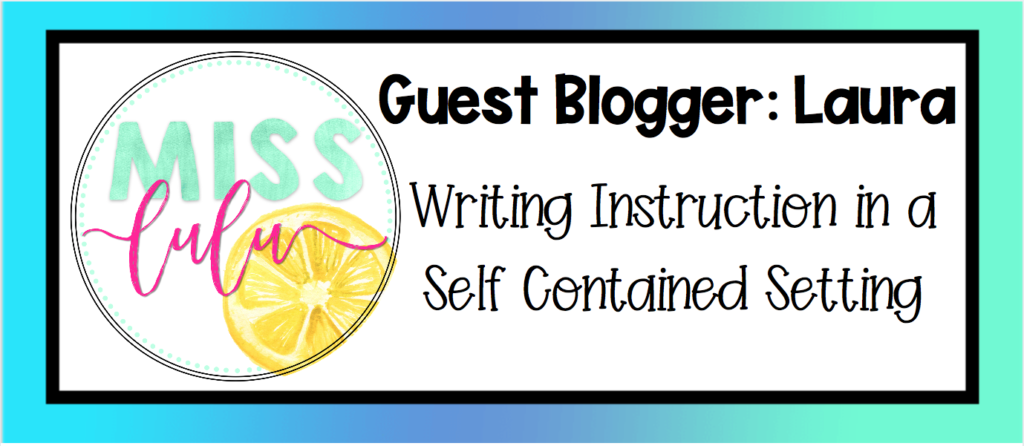I’m excited to introduce this week’s guest blogger Laura from Miss Lulu Special Ed to talk all about how to teach writing instruction in a self-contained classroom!

Writing can be overwhelming for students, and it can be overwhelming to teach. There’s not a great writing program out there for students with disabilities. This is often an area where students have not had a lot of instruction and practice. We need to explicitly teach writing instruction to student is a self-contained program.
I like to start my writing groups with expository writing. This is an easy way to start because it is very concrete. It’s easy to help them edit and learn to grow their writing skills when we are sticking strictly to the facts. Here’s the process I go through when teaching expository writing and how I scaffold my instruction to slowly introduce each part.
We start with complete sentences. Before we can move any further, students have to know how to write a complete sentence. They have to understand what a complete sentence needs. We also focus on editing during this part of the year. It’s easy to tie into sentence writing because I can provide lots of examples and nonexamples and they can help me correct the sentence so that it is complete. You can grab this free anchor chart in my resource library.
Next, I teach my students to gather text evidence and write notes. We usually do a bubble graphic organizer, with our topic in the middle and details all around. You’ll want to explicitly teach your students what details are and how to find them. With every step of writing instruction, you will need to do lots of modeling. Talk through what you are doing. Explain your thoughts out loud. Find good mentor texts that have lots of examples.
Next, we work on detail/supporting sentences in writing instruction. These are the easiest because they come straight from the notes that they took. They look through their notes and select 3-4 details that they want to write sentences about. We mark these directly in their notebook. I scaffold my instruction by providing a topic sentence and a conclusion sentence for them. This lets them focus on writing clear and complete detail sentences. Writing instruction can be so important in your self contained classroom.
Next for writing instruction, we work on conclusion sentences. I teach my students that the conclusion sentence wraps up, or summarizes, our writing. The conclusion sentence should help the reader answer the question, “What did I read about?”
And finally, we work on topic sentences. This is a tricky one. Too often, my students want to write just a title, or a sentence like, “This is about frogs.” So to avoid this, I teach my students that a topic sentence needs to be a complete sentence that grabs the reader’s attention and introduces the topic. I like to give them three ways to write a topic sentence. First, they can write it as a “Did you know” question. Second, they can write a describing sentence. Or third, they can write an interesting fact about the topic.
This gives them enough choice but also enough structure that their sentence can really narrow down the topic and be specific. We practice this a ton. Topic sentences are the hardest part for my students. Even though I am giving them the topic sentence earlier in the previous steps, I like to talk through how to write it and model repeatedly so that when they get to this step, it’s not brand new.
By scaffolding and teaching each part explicitly, they are able to learn one step and a time and then add in the next part. I have my students for 2 years, and teaching expository writing usually takes the majority of the first year. But then, they have the basics and in the second year we can focus on narrative writing, writing letters and emails, and even “how to” writing.
If you have questions about writing instruction in a self contained classroom, or want to brainstorm ideas, you can find me on Instagram @missluluspecialed or on my website at www.missluluspecialed.com. I’d love to hear from you!
Read more about how to adapt math curriculum for your students too!
Learn more about writing IEPs!
Find a new blog to read!
Instagram | TeachersPayTeachers | Facebook | Boom Learning Library | Pinterest | Youtube
What are you looking for?
COPYRIGHT © 2025 Full SPED Ahead